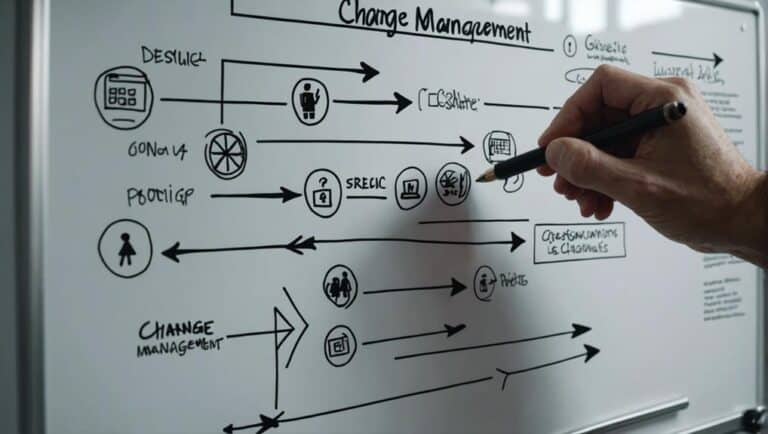When you want to steer change within your organization, how you communicate can make a world of difference. Crafting effective change management emails isn't just about giving out information; it's about guiding your team through a transformative process with clarity and empathy.
If you follow a structured approach and use key strategies, you can ensure that your messages resonate and drive positive outcomes. So, how do you master the art of crafting impactful change management emails that truly inspire action and understanding?
Key Takeaways
Hey team,
I wanted to chat with you about some upcoming changes we are making to our project management system. We've been reviewing our current processes and after careful consideration, we believe that updating our tools will help streamline our workflow and improve overall efficiency.
By switching to a new project management system, we aim to enhance collaboration, increase productivity, and provide better visibility into project status and progress. This change aligns with our goal of optimizing our resources and delivering projects more effectively to meet our strategic objectives.
To ensure a smooth transition, we have developed a structured timeline for the implementation of the new system. We will be providing training sessions and resources to support everyone through this change. Our goal is to empower you with the knowledge and tools needed to make the most of the new system.
We understand that change can sometimes be challenging, so we are here to address any concerns or questions you may have. It's important to us that everyone feels supported throughout this process. Your feedback is also valuable to us, so please don't hesitate to share any thoughts or suggestions you may have.
We are committed to transparency and will keep you informed every step of the way. If you have any concerns or encounter any issues during the transition, please reach out to the project management team. Together, we can make this transition a success and improve our project management processes for the better.
Thanks for your understanding and cooperation as we work towards enhancing our project management capabilities.
Best, [Your Name]
Purpose of the Communication
When you're putting together your change management email, make sure to clearly explain why the changes are happening and what to expect. Good communication is crucial during times of change, as it helps employees understand the reasons behind the upcoming changes. By outlining the goals and objectives of the change management plan, you can get everyone on the same page and build a sense of unity within the team.
It's important to spell out the reasons for the changes so that employees can get on board. When you provide a clear explanation of why these changes are needed, it helps employees see how they fit into the bigger picture. This clarity can help ease any concerns or doubts employees might have, making them more open to the changes.
In your change management email, be sure to explain the purpose in a way that resonates with your employees. This can help foster a sense of belonging and unity within the team, laying the foundation for a smoother change management process.
Providing Context for Change
To help everyone understand why we're making these changes, let's start by explaining the reasons behind them. By giving background information on why we need to shift things around, we can show why it's important to do so.
Let's make sure to lay out the goals and the benefits we expect to see from these changes, so everyone is on the same page with our overall strategy.
Why Change Is Needed
Understanding why change is needed is crucial for getting employees on board and aligned with the organization's goals. When you explain the reasons for change in your emails, it helps employees see the big picture and reduces confusion and resistance. By giving specific examples or data, you can show the importance and urgency of the changes, making it clear why they're necessary.
When you break down the 'why' behind the changes, you create a shared understanding of where the organization is heading. This not only helps employees grasp the reasons for change but also fosters a sense of unity and purpose in moving forward together. Embracing these changes can improve collaboration and create a more cohesive work environment for everyone.
Impact on Stakeholders
To really understand how upcoming changes will affect you, it's important to know how they'll directly impact your role and what you bring to the table in the organization.
When you include details in your emails about why the changes are happening, what's being proposed, and how it'll affect everyone, it gives you a clear picture of what's going on. This not only helps you see why the changes are necessary, but also sets the stage for better communication and engagement.
Communicating Benefits Clearly
Crafting change management emails that clearly outline the benefits of upcoming changes is crucial for making sure employees understand why the changes are happening. When you highlight the improvements and link the changes to the organization's strategy, you can help employees see how the changes align with the company's goals.
It's important to send clear messages that show the advantages of the upcoming changes and use examples or case studies to demonstrate potential outcomes. When you communicate the benefits clearly, think about employees' communication preferences to make sure your message resonates with them effectively.
Providing context will help them not only grasp the changes but also feel more connected to the overall strategy, creating a sense of belonging and purpose within the organization.
Explaining Impact on Individuals/Teams
When dealing with change and its impact on individuals and teams, it's important to understand their specific worries and uncertainties. Let's look at how different roles and duties might be influenced. For instance, team members might see changes in their daily tasks and routines.
Imagine a scenario where a team that previously had set roles now needs to adapt to a more collaborative approach. This shift could mean team members need to work more closely together, sharing responsibilities and decision-making.
In this new setup, individuals might find themselves taking on tasks they're not used to, which can lead to some anxiety or confusion. It's crucial to address these concerns openly and create a space for team members to voice their thoughts and ideas.
Individual Concerns Addressed
Hey there, it's important to understand how the upcoming changes will impact you and your team directly. Let's look at some key points to address individual concerns during this transformation:
- We'll provide personalized information tailored to each team member's role.
- We'll highlight the specific benefits and opportunities the change will bring to you.
- We'll offer support and guidance to help you navigate the changes effectively.
- We'll address your questions and feedback promptly.
- We'll make sure effective communication channels are in place for ongoing updates and clarifications.
Team Involvement Strategies
To get your team on board with the upcoming changes, make sure to show them how these adjustments will directly impact their day-to-day work and relationships within the team. Let them know how their roles will evolve, pointing out the advantages and new opportunities that will arise for specific teams in the organization. By explaining how these changes will lead to better teamwork and communication across teams, you can create a more united and collaborative work environment.
It's important to address any potential obstacles that certain teams might face during this transition. Be ready to provide tailored support and resources to help them navigate and adapt smoothly. By being transparent and acknowledging the challenges ahead, you can build a sense of solidarity and preparedness for embracing change. Remember, teamwork is essential for successfully implementing organizational changes.
Communication Plan Tailored
Craft your change management emails to specifically address how the upcoming changes will impact you and your team directly. We want to make sure everyone is on the same page and feels supported through these changes. Here are five key things to keep in mind as we navigate this together:
- Personalize messages: We'll highlight how the changes affect each individual's role, so you can see the direct impact on your day-to-day work.
- Address team concerns: Your thoughts and needs are important to us. We want to ensure that everyone feels valued and engaged throughout this process.
- Communicate openly: We're committed to being transparent every step of the way. Open communication is key to building trust and understanding during times of change.
- Tailor messages: Different teams may have different needs and concerns. We'll make sure to address these specific audience segments to have the greatest impact.
- Emphasize personalized communication: By focusing on individual needs and concerns, we can create a supportive environment for all team members.
We're here to support you through these changes and welcome any questions or feedback you may have. Let's work together to make this transition as smooth as possible.
Detailing Implementation Timeline
When you're planning out how to make changes in your organization, it's super important to be clear and specific about the timeline. The timeline is like a roadmap that lays out all the dates and milestones for when the changes will happen. It's basically a step-by-step plan for carrying out the changes on time, making sure everyone knows what's happening and when. Having a clear timeline helps everyone understand when the changes will happen and how they'll be rolled out, which cuts down on confusion and uncertainty for employees.
A well-defined timeline is crucial for making sure change management goes smoothly. It sets the pace and direction for the transformation you're aiming for. By sharing this schedule openly and with lots of detail, you're including everyone in the process and getting them ready for what's to come. This openness and preparation help make the whole implementation process go more smoothly and successfully.
Offering Support/Resources for Concerns
When your organization is going through changes, it's important to take care of your employees' worries by offering them the right support and resources. By addressing their specific concerns and communicating with them in a personalized way, you show that you understand and care about their needs, which helps build trust during the change process. Providing guidance and help to your employees can make it easier for them to deal with uncertainties and adapt to the new situation.
It's crucial to create a safe space where employees can freely express their concerns and provide feedback. This feedback is valuable as it can help you improve your change strategies and make the transition smoother for everyone. Giving your employees access to resources and support systems is key because it gives them the tools they need to face challenges confidently and embrace the change positively.
Remember to support your employees throughout the change, tailor your communication to address their individual worries, encourage open communication for valuable insights, empower them with resources, and build trust through support and clear communication. By doing so, you can make the change process more manageable and successful for everyone involved.
Managing Expectations Effectively
When things are changing at work, it's super important to keep everyone in the loop. Make sure to tell your team about what's happening, when it's happening, and why it's happening. This helps manage their expectations and makes it easier for them to adjust. You want to be real about what's going on to avoid any pushback and help people get on board with the changes.
If your team has concerns, address them in your emails. Let them know that you hear them and that you're there to support them through the process. Reassurance goes a long way in calming fears and building trust. Be sure to explain the benefits of the changes so everyone understands what's in it for them.
Keep your team updated with regular emails about the progress of the changes. This helps them see that things are moving forward and makes them feel more involved in the process. By keeping the lines of communication open, you can create a sense of security and understanding among your team. Remember, being empathetic and transparent can make all the difference during times of change.
Fostering Transparency and Smooth Transition
To smoothly navigate through changes, you need to be transparent. This means consistently providing clear and informative communication to your team. Here are some strategies to promote openness and ensure smooth transitions during change management:
- Explain the Impact of the Change: Let your team know why the change is happening and how it will affect them.
- Keep Everyone Updated: Provide regular progress reports and updates to maintain alignment.
- Address Concerns in Emails: Engage employees by answering their specific questions and concerns in your communications.
- Reduce Confusion: Clear communication helps reduce uncertainty and facilitates smoother adjustments.
- Boost Employee Engagement: By tailoring emails and being transparent, you can help employees feel more connected and supported.
Frequently Asked Questions
How Do You Write a Change Management Email?
When you're writing an email about changes, make sure you cover the important stuff clearly. Get everyone on board by showing that leaders support the change, stakeholders are on board, and there's training to help out. If people push back, keep the conversation going and check how ready everyone is for the change to actually happen.
What Are the 7 Steps of Change Management?
To effectively navigate the 7 steps of change management, you need to involve stakeholders, plan your communication strategy, address any resistance, offer training, work closely with teams, gain support from leadership, analyze data, and set up feedback channels. These elements are crucial for successful transformations.
What Are the 5 C's of Change Management?
If you want to do well in change management, just keep in mind the 5 C's: Communication, Collaboration, Clarity, Consistency, and Compassion. These are the key principles for making organizational changes work smoothly. So, make sure to communicate clearly, work together, keep things transparent, be consistent, and show empathy. By following these principles, you can make sure your employees are engaged, get stakeholders on board, and create a culture that's open to change.
What Are the 7 R's in Change Management?
When you're in charge of making changes, remember to consider the 7 R's: reasons, return on investment, risks, resources, responsible parties, relationships, and roadmap. By looking at these factors, you can steer change in the right direction and reach successful results.
Conclusion
As you go through changes, just remember that every storm eventually ends, showing a better tomorrow. Face the journey ahead with courage and strength, knowing that each step takes you closer to growth and change.
We can handle any challenge together and come out even stronger. Trust the process, seek support, and keep moving forward with a steady heart.
A new beginning is on the horizon.





